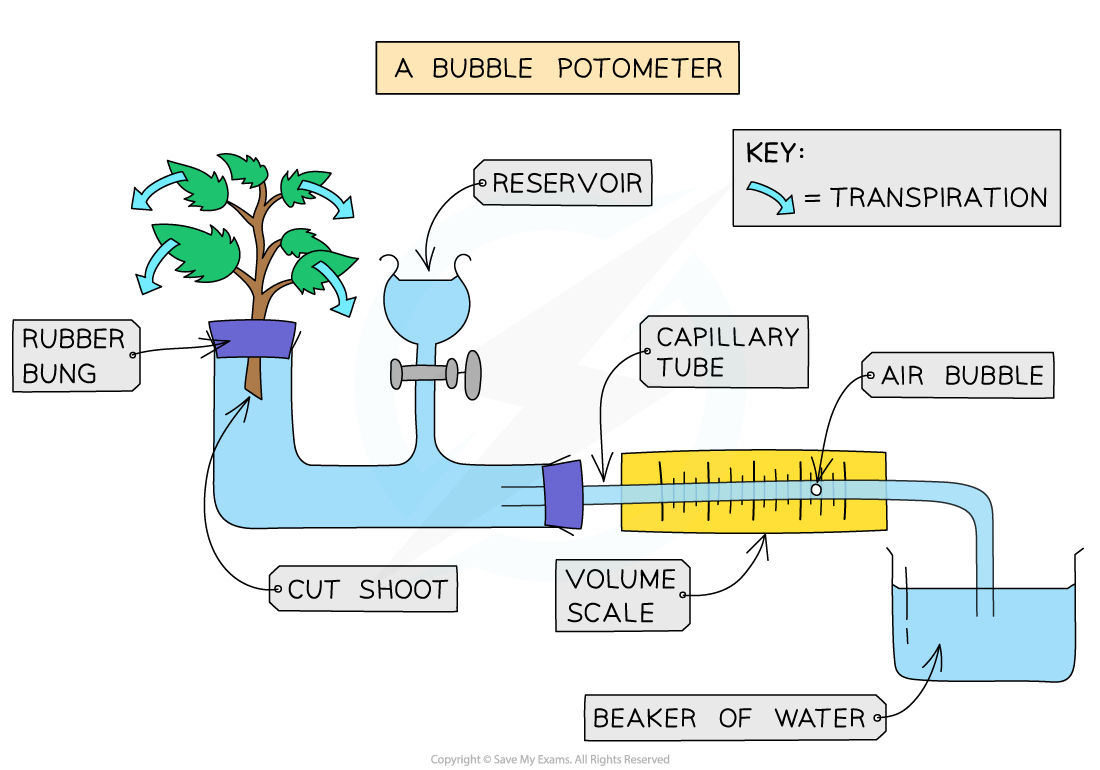Practical: Transpiration (SQA National 5 Biology): Revision Note
Exam code: X807 75
Investigating factors affecting the rate of transpiration
We can investigate the effect of environmental conditions on the rate of transpiration using a piece of apparatus called a potometer
It is possible to investigate environmental factors such as:
wind speed
humidity
surface area
temperature
There are two types of potometer:
a mass potometer measures the change in mass as a measure of the volume of water that has evaporated
a bubble potometer measures the uptake of water by a stem as a measure of the volume of water that is being lost by evaporation


Examiner Tips and Tricks
Note that this practical is a 'suggested practical' in the specification, rather than content that all students are expected to learn. Some schools may choose to complete alternative practicals, or may miss out practical work that is not realistic, e.g. due to equipment or time constraints
Investigating the effect of wind speed on transpiration using a bubble potometer
Apparatus
Leafy shoot
Basin of water
Scissors or scalpel
Bubble potometer
Petroleum jelly
Fan
Ruler
Timer
Method
Cut a shoot underwater; the cut should be at an angle
Cutting under water prevents air from entering the xylem and causing a blockage
Cutting at an angle increases the surface area for water uptake
Set up the apparatus as shown in the diagram
Make sure it is airtight, using petroleum jelly to seal any gaps
Dry the leaves of the shoot as wet leaves will affect the results
Remove the capillary tube from the beaker of water to allow a single air bubble to form and place the tube back into the water
Set up a fan 10cm from the leaf and turn it on
Allow the plant to adapt to the new environment for 5 minutes
Record the starting location of the air bubble
Leave for 30 minutes
Record the end location of the air bubble
Change the wind speed (low, medium or high)
Reset the bubble by opening the tap below the reservoir
Repeat the experiment
Calculate the rate of transpiration by dividing the distance the bubble travels by the time period


Other environmental factors can be investigated using the same set-up:
Humidity: spray water in a plastic bag and wrap around the plant
Temperature: temperature of room (cold room or warm room)
Expected results
As wind speed increases, the rate of transpiration should also increase
This will be shown by the bubble moving a greater distance in the 30 minute time period when the fan speed is increased from lower to higher speed
Transpiration rate increases with wind speed because moving air removes the humid boundary layer of water vapour around the leaf surface
This helps to maintain a steep diffusion gradient between the moist air inside the leaf and the drier air outside
A steeper concentration gradient results in increased diffusion of water vapour out of the leaf through the stomata, therefore increasing transpiration
Limitations
Limitation | Possible solution |
|---|---|
The potometer equipment may have a leak | Ensure that all equipment fits together rightly around the rubber bungs Assemble underwater to help produce a good seal Use petroleum jelly around the joins |
The plant cutting has a blockage due to air entering the xylem | Cut the stem underwater Place the stem into the potometer underwater to minimise opportunities for air bubbles to enter the xylem |
The potometer shows no change during the experiment | Use the plant cuttings as soon as they have been cut from the plant; transpiration rates may slow down when the cuttings are no longer fresh |
Changing temperature during the course of the experiment | Monitor air temperature with a thermometer Close any blinds so that room does not heat up |

Unlock more, it's free!
Did this page help you?